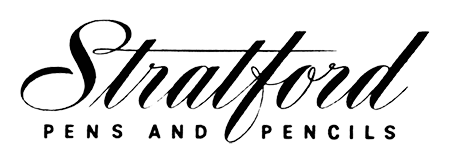Stratford Wonder-Fill Fountain Pen 1955
by Jim Mamoulides, October 27, 2023
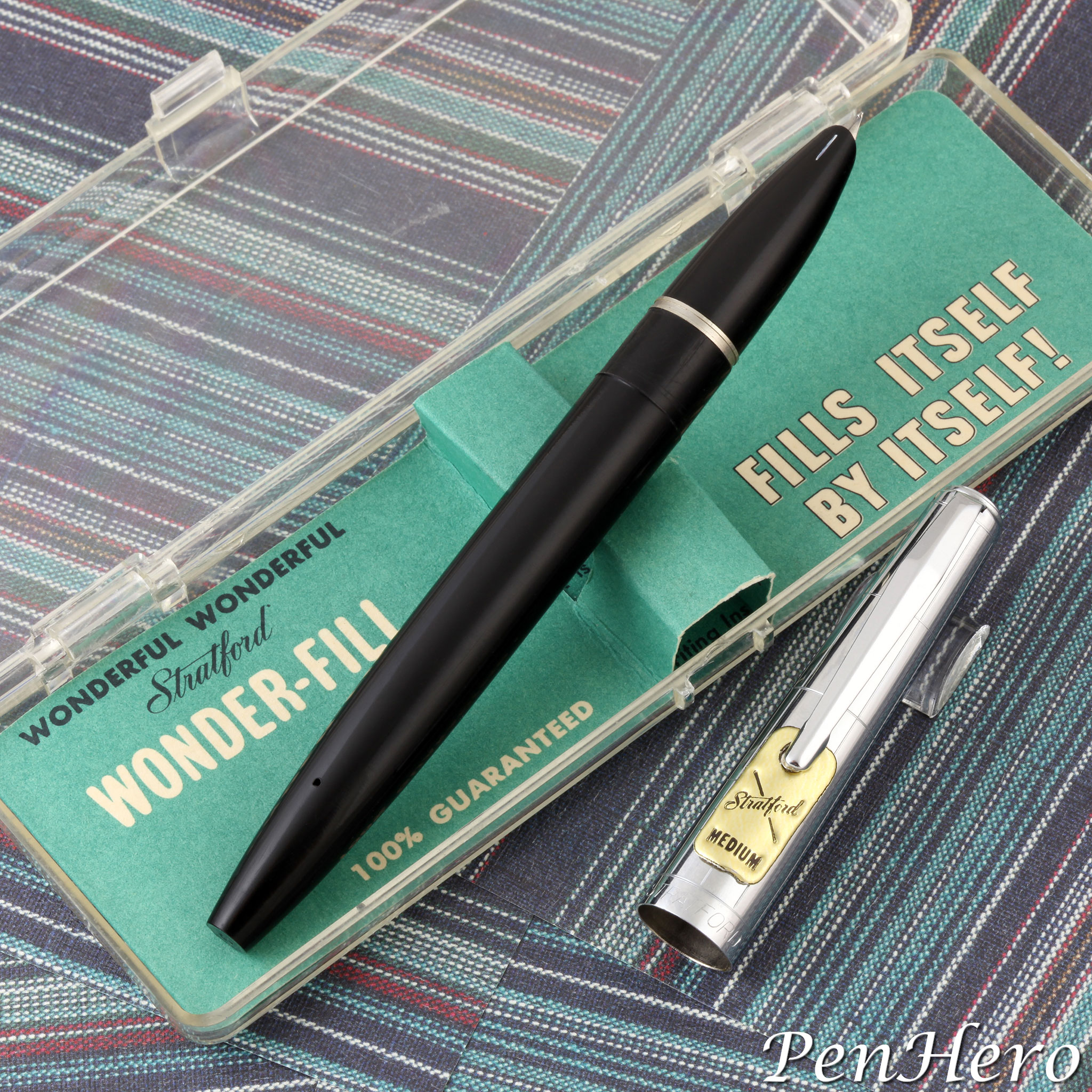 Stratford Wonder-Fill fountain pen 1955
Stratford Wonder-Fill fountain pen 1955
Fills Itself By Itself!
The Stratford Wonder-Fill fountain pen was the first of three capillary filling pens introduced in United States in the 1950s, a type of pen that fills by dipping it in ink, wicking ink into a chamber inside the pen filled with an absorbent medium to store it. The concept simplifies filling the pen to dip, wait, and wipe. Introduced in 1955, this 5 7/16 inch long pen is similar in concept to the later Waterman “X-Pen” which also filled by dipping the nib into ink and waiting about twenty seconds for it to fill by soaking up the ink into an absorbent medium, probably cotton, inside the barrel. The Stratford Wonder-Fill preceded the most successful capillary filling pen, the Parker 61, which was test marketed as early as 1953 but not officially released until 1956 and the Waterman X-Pen, introduced in the United States in 1959. The concept of making a capillary filling pen had been patented before, with the earliest being U. S. Patent 1,336,119 awarded to Jörgen Thorvald Andersen on April 6, 1920 for a capillary filling stylographic pen, as well as in Denmark, France, Great Britain and Germany. There was also a Bibax capillary style ink filling fountain pen
An advertisement search for the Wonder-Fill shows only ads from 1955. The earliest is a June 6, 1955 Macy’s ad in the New York Times describing the $2.98 pen as “The Fountain Pen That Fills Itself By Itself.” Listed features focused on its simplicity and clean use, using phrases like nothing to insert, push, pull or change, no leaking, even on a plane, and will not clog. What a marvel! And like Henry Ford’s Model T, it only came in black, with a chrome plated cap. By November, 1955 it was being offered with a matching pencil for $4.98, but still only in black. This example has a medium stainless steel nib, which I am assuming is standard issue.
Why Even Make Capillary Pens?
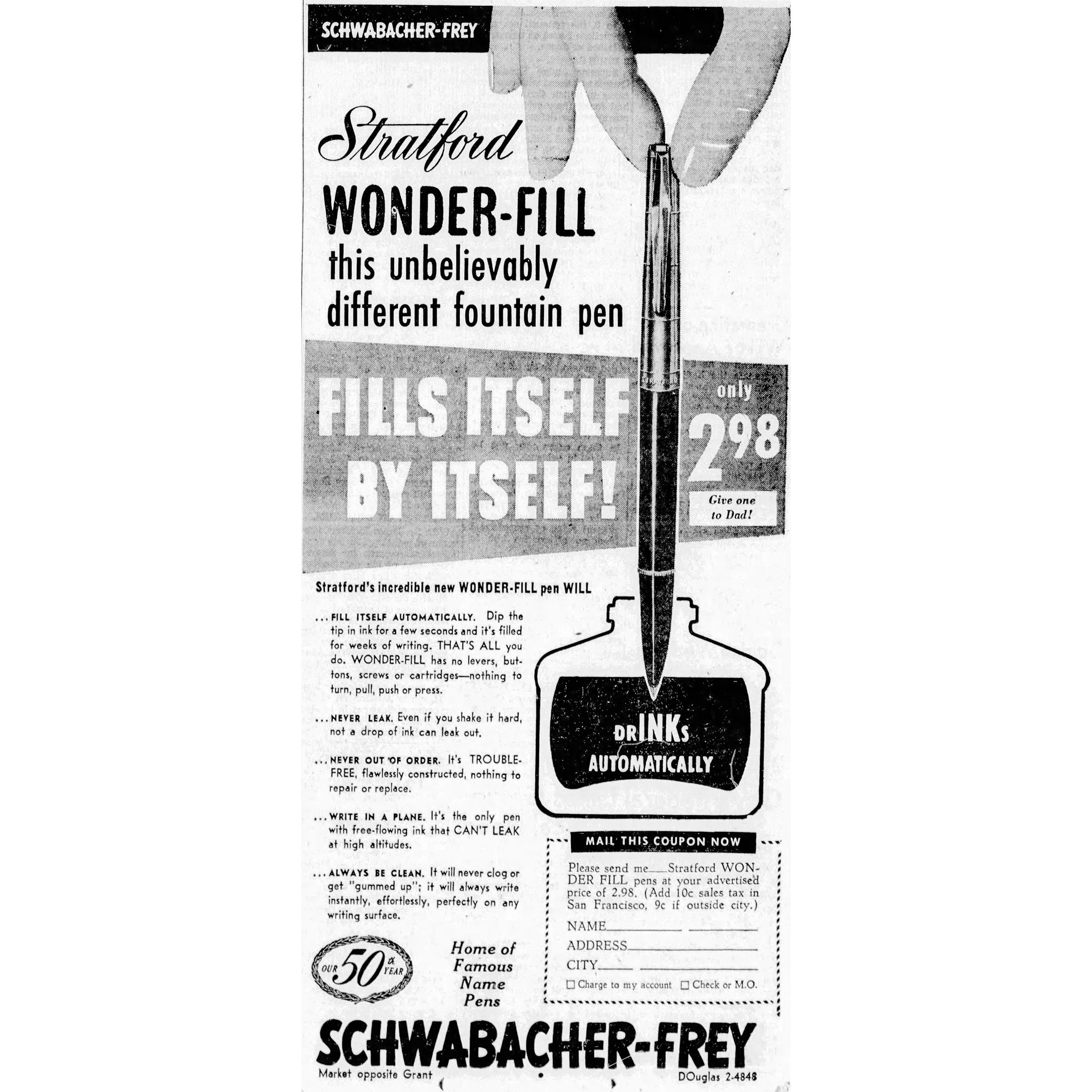 Advertisement, The San Francisco Examiner, June 15, 1955
Advertisement, The San Francisco Examiner, June 15, 1955
The launch of the BIC Crystal in 1950 ushered in the biggest existential threat to the fountain pen industry: cheap ballpoint pens. This energized pen companies to come up with or overhaul their own ballpoint pens and also to introduce simpler, cleaner filling fountain pens. This included Stratford, which was also making push button ballpoint pens by 1955. The result was many pen companies shifted to cheaper offerings, went upscale, adopted simpler fountain pen filling systems such as the ink cartridge, or folded completely by the early 1960s.
How Did Stratford Scoop Parker?
Parker applied for patents for a capillary filling pen system four times between 1946 and 1952. The first was by H. H. Zodtner on July 17, 1946 and awarded as U. S. Patent 2,462,929 on March 1, 1949. Floyd E. Bartell applied for two on March 3, 1947 and on September 23, 1950, and he and the assignee Parker Pen Company were awarded U. S. Patent 2,522,555 September 19, 1950 and U. S. Patent 2,648,309 on August 11, 1953. The third patent, by Nolan Kent Rhoades, was applied for on March 1, 1952 and U. S. Patent was 2,773,479 awarded on December 11, 1956.
The earliest Parker internal model photo for the capillary filling 61 is dated September 23, 1953 and shows a clear plastic Parker 61 Mark I pen, a functional model with an “over-fill” mechanism that is catalogued as Model 1-P-131. Early Parker 61 capillary pens also filled through the nib section, though the final production models have a Teflon coated capsule with openings in the base that is accessed by removing the barrel and the pen filled by dipping the end of the capsule in ink. The capillary filling Parker 61 was “formally” announced on September 18, 1956.
Without any internal Stratford Pen Corporation information, it’s unknown how the company independently came up with the idea for the Wonder-Fill pen. It's possible that the company, previously known as Salz Brothers, and holders of several patents of their own, though mostly design patents, may have noticed the Parker capillary system patent awards and attempted to be a first mover with this new type of filling clean filling system with a lower price point pen. I suspect reverse engineering of Parker’s patent, given the similarity to the earliest Parker 61 type.
What’s also not known is what the ink absorbing medium is inside the Wonder-Fill barrel. I hoped the barrel simply unscrewed from the section, but it appears it’s sealed, which makes sense considering there is nothing inside the user needs to deal with. I suspect it’s not as sophisticated as the pierced plastic sheet rolled up inside the Parker 61’s ink capsule but more like the cotton fabric inside the Waterman X-Pen. Since I’m not going to sacrifice the only Wonder-Fill I have to find out, that will remain a mystery for now. If the reader has one that has been opened, I would like to know what’s inside!
Waterman had a similar idea with the X-Pen, introduced in the U. S. in 1959, the year after the company was sold to Marcel Bich of BIC Crystal fame. Like Stratford, Waterman holds no U. S. patent on the X-Pen filling system that I could find. The X-Pen also seems to have had a short sales life in the U. S., with advertisements beginning in 1959 and very quickly diminishing.
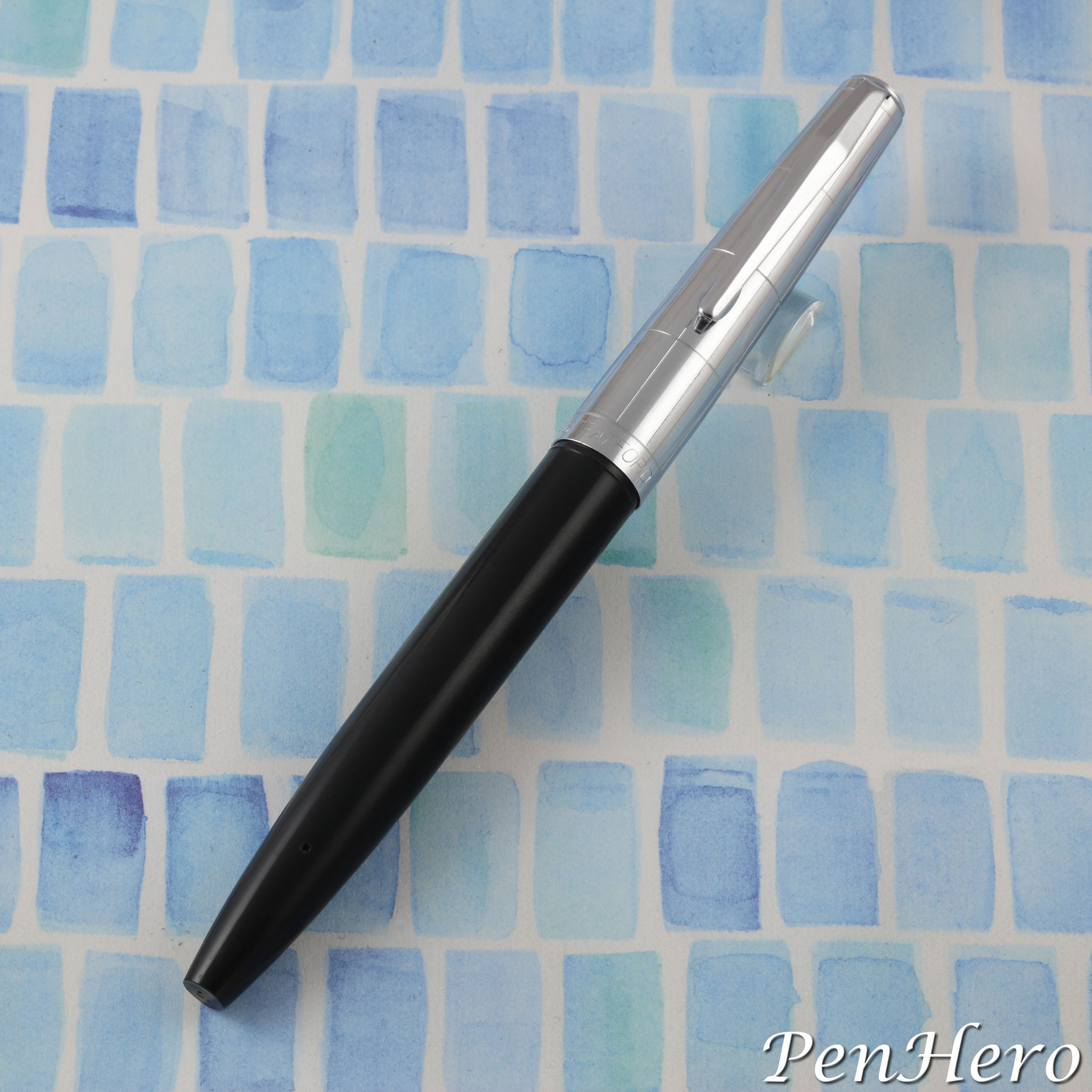 Stratford Wonder-Fill fountain pen 1955
Stratford Wonder-Fill fountain pen 1955
Identification guide and features:
From the very limited sources I’ve been able to uncover the Stratford Wonder-Fill fountain pen was probably only made in 1955 and only came in one color and with one trim level.
- Chrome plated metal cap and black plastic barrel
- Cap engraved or etched with a rectangle box pattern
- Cap stamped STRATFORD at bottom front
- Chrome plated clip
- Slip on cap
- Stainless steel hooded nib – only grade known is medium
- Black plastic section with raised painted line near nib tip
- About 5 7/16 inches long capped
- Fills by inserting nib into ink
- Sold in clear plastic gift box with pen only for $2.98 or pen and matching pencil for $4.98
Performance
I‘ve only ever seen one of these pens and internet searches show very few mentions of them. Since they apparently only sold for one year, 1955, I’m going to guess that they did not do well in the market and with the introduction of the Parker 61 the next year, the Wonder-Fill undoubtedly faded quickly into obscurity.
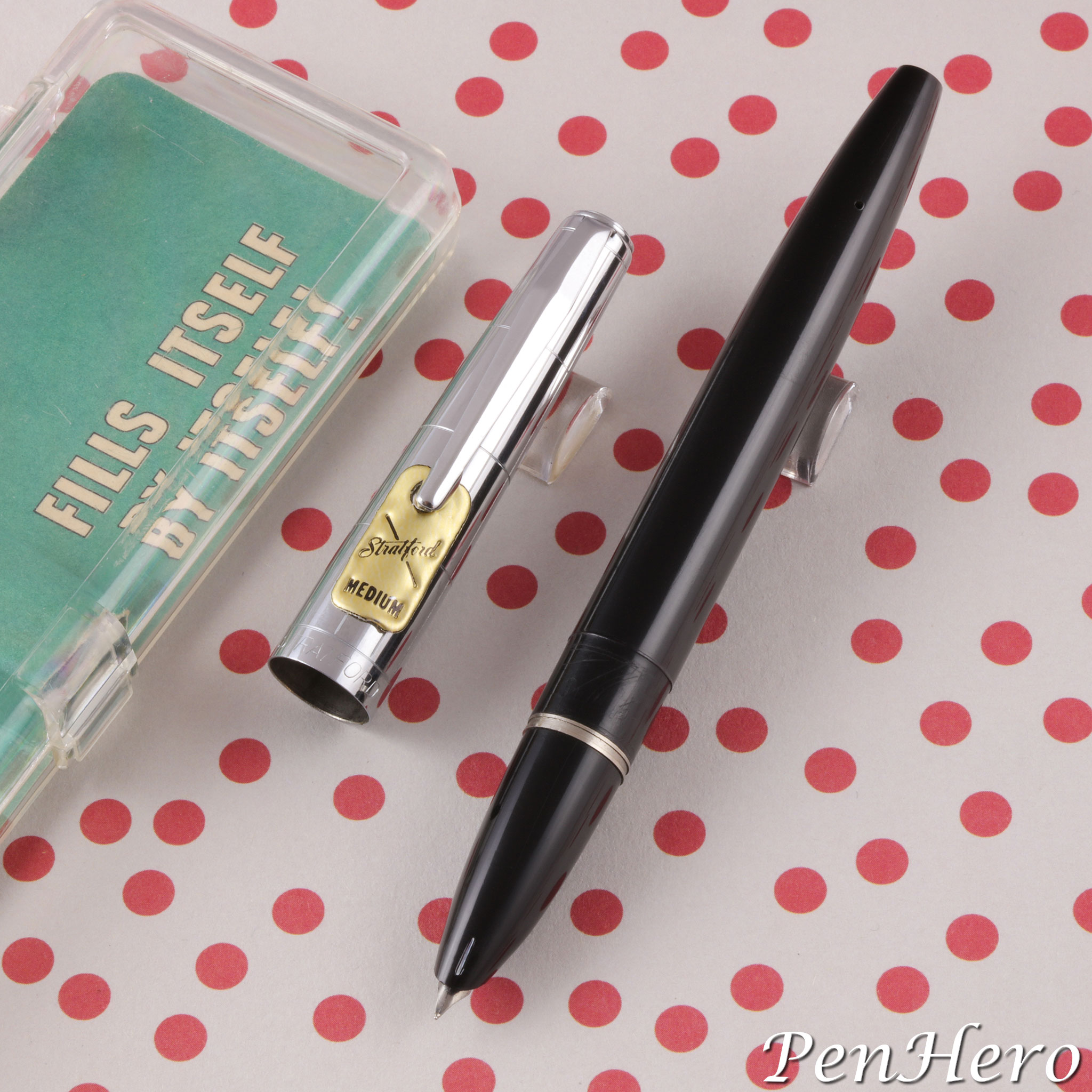 Stratford Wonder-Fill fountain pen 1955
Stratford Wonder-Fill fountain pen 1955
Because this example appears to be unused, I decided to leave it unfilled. The fit and finish is pretty good. Everything is snug and tight, and the bright chrome plated metal cap looks quite nice. It probably looked like it was worth the $2.98 it cost in 1955. Since I did not want to ink it, I had to test the nib by dry writing, which suggests it was probably a reasonably smooth writer. It appears aligned and has tipping material.
The filling instructions are as expected, “dip the tip in ink up to but not above the metal ring for 20 seconds … remove and wipe dry.” The tell for when it needs refilling is when it starts to write lighter. The instructions for cleaning the pen were interesting, “Once every six months, fill pen with cold water to keep in top condition. Yes, it will write with water temporarily, a fact to remember at times when no ink is handy.” Given there is no other way to flush the pen, filling with water and then writing out the water until clear would prove tedious, especially if considering a change of ink color! Stratford must have really wanted their users to like their pen as the instructions shout in bold all caps, “A THRILLING NEW WRITING EXPERIENCE!”
I think these pens are likely very uncommon, if not rare. The lack of them on the secondary market hints that they did not work very well and I’m going to guess that most were binned. Given its standing as one of the very few attempts at a capillary filling pen, and likely the first to market, the Stratford Wonder-Fill would make a great addition to any collection focusing on filling systems.
Acknowledgement
Thanks to David Nishimura for providing additional information on early capillary filling systems.
References
1-P-131 – 61 Mark I pen Parker internal photograph, dated October 29, 1953
Advertisement, The Gazette, November 8, 1955, page 10
Advertisement, The Commercial Appeal, November 10, 1955, page 19B
Advertisement, The New York Daily News, June 8, 1955, page 23
Advertisement, The New York Times, June 6, 1955, page 11
Advertisement, The San Francisco Examiner, June 15, 1955, page 4
Bibax capillary style ink filling fountain pen, by Matthew Greenberger, Vintage Fountain Pen Doctor
Parker 61 1956-1983, by Tony Fischier, Copyright © 1995-2019 Tony Fischier and The Parker Pen Company
“Revolutionary New Type Pen Created by Parker” Janesville Daily Gazette, September 18, 1956, page 1
United States Patent 1,336,119 awarded on April 6, 1920
United States Patent 2,462,929 awarded on March 1, 1949
United States Patent 2,522,555 awarded on September 19, 1950
United States Patent 2,648,309 awarded on August 11, 1953
United States Patent 2,773,479 awarded on December 11, 1956
“Waterman Pen Sold To Parisian” The Miami News, November 25 1958, page 9
Waterman X-Pen, by David Nishimura, Copyright © 1997-2023
Interact
Comments on this article may be sent to the author, Jim Mamoulides


